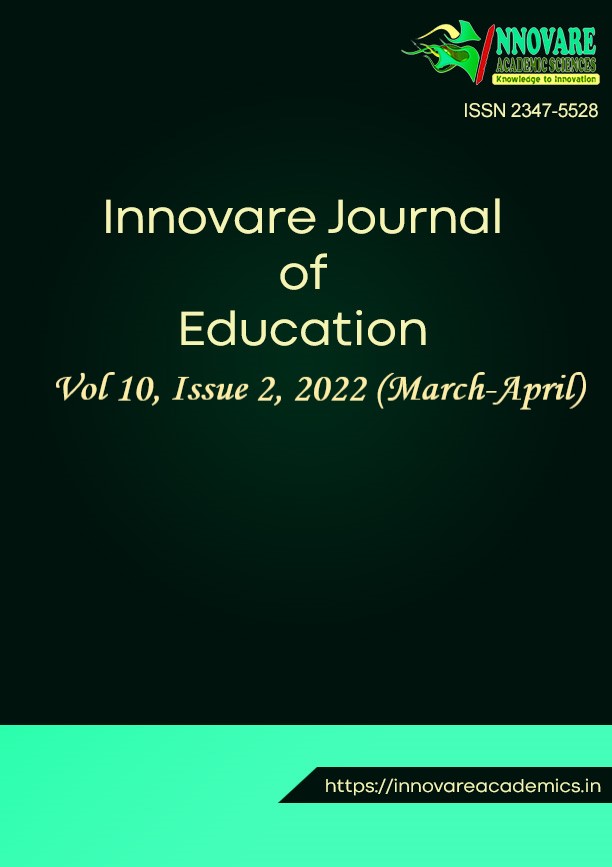The Effect of Music on Cognitive Control among Media Multitaskers
DOI:
https://doi.org/10.22159/ijoe.2022v10i1.43672Keywords:
media multitasking, cognitive control, music, StroopAbstract
The objective was to understand the performance differences of heavy and light media multitaskers. Further, the differences across media multitasking groups when the subjects are performing a cognitive task in the presence of music were studied to understand the role of music in cognitive performance in terms of cognitive control. A sample of 300 girl students from the Government schools of Chandigarh in the age range of 14-18 years (mean age= 15.7 years) was taken for the purpose. The media multitasking questionnaire (Ophir et al., 2009) and the Stroop task (Stroop, 1935) were used. The two media multitasking groups, viz., heavy and light media multitaskers, significantly differed from each other. Media multitasking and cognitive control were found to be linked and the role of music indicated facilitating trend for performance. Studies conclude high levels of media multitasking result in poor cognitive performance in terms of cognitive control and music plays a facilitative role for such media multitasker’s cognitive control.
Downloads
References
Alolaiwi, H. N. S. (2017). Gender trouble and the tragic black Woman hybrids IN Clotel, quicksand and passing. Journal of Arts and Humanities, 6(6), 08–14. https://doi.org/10.18533/journal.v6i6.1185
Aramendia-Muneta, M. E., Olarte-Pascual, C., & Hatzithomas, L. (2019). Gender stereotypes in original digital video advertising. Journal of Gender Studies, 29(4), 403–419. https://doi.org/10.1080/09589236.2019.1650255
Baker, S. E. (2017). A glamorous feminism by design? Cultural Studies, 31(1), 47–69. https://doi.org/10.1080/09502386.2016.1167928
Bodjawah, E. K., Seid’ou, K., Sosu, S. A., & Ayim, B. (2018). Materializing the image, imaging the material: African Facemasks in second life. Journal of Arts and Humanities, 7(4), 22–31. http://dx.doi.org/10.18533/journal.v7i4.1364
Hamamra, B. T. (2020). The misogynist representation of women in Palestinian Oral tradition: A socio-political study. Journal of Gender Studies, 29(2), 214–226. https://doi.org/10.1080/09589236.2019.1604328
Himawan, D. (2006). Menuju ke hulu meraih kejernihan di kepekatan fenomena kebudayaan kontemporer [Heading upstream to achieve clarity in the concentration of contemporary cultural phenomena]. In A. Adlin (Ed.), Spiritualitas dan Realitas Kebudayaan Kontemporer (hal 9–24) [Spirituality and the reality of contemporary culture (pp. 9–24)]. Jalasutra.
Hopner, V., & Chamberlain, K. (2020). Commodifying femininity: The online offering of breast augmentation to New Zealand women. Journal of Gender Studies, 29(6), 651–663. https://doi.org/10.1080/09589236.2019.1673153
Ismaili, V. K. (2019). Female representations in byzantine art of Kosova. American Journal of Art and Design, 4(4), 41–47. https://doi.org/10.11648/j.ajad.20190404.11
Isrow, Z. (2017). Defining art and its future. Journal of Arts and Humanities, 6(6), 84–94. https://doi.org/10.18533/journal.v6i6.1207
Kim, E. (2020). Re-feminizing the post-Soviet women: Identity, politics and virginity ceremonies in contemporary Kyrgyzstan. Journal of Gender Studies, 29(6), 706–716. https://doi.org/10.1080/09589236.2020.1758043
Lough, K. (2020). Patriarchal pits: The gendered experiences of female concert photographers. Journal of Gender Studies, 29(7), 820–831. https://doi.org/10.1080/09589236.2020.1821178
Marianto, M. D. (2017). Seni dan daya hidup [Arts and life style]. Scritto Books Publisher.
Moleong, L. J. (2010). Metodologi penelitian kualitatif [Qualitative research methodology]. P T Remaja Rosdakarya.
Rahmani, J., & Tayebinia, M. (2018). Women’s reflexive identity and spirituality case study: Iranian employed, degree-holder women. Pertanika Journal of Social Science and Humanities, 26(T), 197–214.
Ratna, N. K. (2011). Metodologi penelitian kajian budaya dan Ilmu sosial humaniora pada umumnya [Research methodology in cultural studies and social sciences humanities in general]. Pustaka Pelajar.
Rohidi, T. R. (1992). Analisis data Kualitatif [Qualitative data analysis]. UI Press.
Sabana, S. (2002). Spiritualitas dalam Seni r. Kontemporer di Asia Tenggara [Spirituality in contemporary art in South East Asia]. ITB.
Saidi, A. I. (2008). Narasi Simbolik Seni Rupa Kontemporer Indonesia [Symbolic narrative of Indonesian contemporary art]. Isac Book.
Strinati, D. (2016). Popular cultural, Pengantar menuju Teori budaya populer [Popular culture, an introduction to popular culture theory]. Narasi.
Sugiharto, B. (2006). Resistensi gaya hidup: Teori dan realitas: Kebudayaan, filsafat dan Seni: Redefinisi dan reposisi [Lifestyle resistance: Theory and reality: Culture, philosophy and art: Redefinition and repositioning]. Jalasutra.
Sumardjo, J. (2000). Filsafat seni [Philosophy of art]. ITB Press.
Sutopo. (2002). Metodologi penelitian kualitatif [Qualitative research methodology]. Universitas sebelas maret.
Teng, F., & Poon, K.-T. (2020). Body surveillance predicts young Chinese women’s social anxiety: Testing a mediation model. Journal of Gender Studies, 29(6), 623–635. https://doi.org/10.1080/09589236.2020.1728523
Themistokleous, G. (2018). From perception to recollection: A spatiotemporal mediated interaction. Studies in Visual Arts and Communication: An International Journal, 5(2), 1–8.
Wang, P. (2017). An analysis of the heroine of north and south: Margaret Hale as an independent woman. Journal of Arts and Humanities, 6(10), 32. https://doi.org/10.18533/journal.v6i10.1289
Published
How to Cite
Issue
Section
Copyright (c) 2022 Heena Parveen

This work is licensed under a Creative Commons Attribution 4.0 International License.





